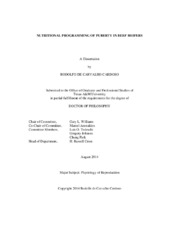| dc.contributor.advisor | Williams, Gary | |
| dc.contributor.advisor | Amstalden, Marcel | |
| dc.creator | De Carvalho Cardoso, Rodolfo | |
| dc.date.accessioned | 2015-02-05T17:24:01Z | |
| dc.date.available | 2016-08-01T05:30:24Z | |
| dc.date.created | 2014-08 | |
| dc.date.issued | 2014-06-26 | |
| dc.date.submitted | August 2014 | |
| dc.identifier.uri | https://hdl.handle.net/1969.1/153316 | |
| dc.description.abstract | Nutritional and metabolic statuses during postnatal development control the timing of pubertal maturation in mammals. Studies reported herein had two overall aims. In Aim I, objectives were to characterize functional and morphological modifications that occur in the neuroendocrine system of prepubertal heifers in response to increased body weight (BW) gain during calfhood. We first tested the hypothesis that hypothalamic release of neuropeptide Y (NPY), an important inhibitory peptide involved in the integration of metabolism and reproduction, would be decreased in heifers that gained BW at higher rates. Confirming our hypothesis, heifers that gained 1 kg/day had lower concentrations of NPY in the third ventricle cerebrospinal fluid than heifers that gained 0.5 kg/day. These data corroborate previous results from our group that demonstrated that similar nutritional treatments result in decreased hypothalamic NPY expression and neuronal projections to gonadotropin-releasing hormone (GnRH) cells. We then tested the hypothesis that proopiomelanocortin (POMC) cells, a critical excitatory metabolic-sensing pathway in the hypothalamus, could be involved in the nutritional control of puberty. Heifers that gained BW at higher rates had greater POMC expression in the arcuate nucleus and an increased number of kisspeptin neurons innervated by fibers containing melanocyte-stimulating hormone alpha (αMSH), a product of the POMC gene. Very few GnRH neurons were observed in close apposition to αMSH fibers and these projections were not dependent on metabolic status. Results suggest that melanocortin signaling through arcuate kisspeptin neurons may be an important mechanism involved in the nutritionally-programed acceleration of puberty in heifers. In Aim II we hypothesized that metabolic programming of processes underlying puberty could be shifted temporally during calfhood through the use of a stair-step, compensatory growth model. Results indicated that nutritional restriction between 6.5 to 9 mo of age did not affect the proportion of heifers pubertal by 12 mo of age when compared to continuous accelerated BW gain. Furthermore, we observed that increasing nutrient availability between 6 and 9 mo of age may potentially time pubertal onset consistently at around 12 mo of age while avoiding precocious puberty. Therefore, similar managerial strategies may allow optimal timing of sexual maturation in replacement beef heifers. | en |
| dc.format.mimetype | application/pdf | |
| dc.language.iso | en | |
| dc.subject | Beef Heifers | en |
| dc.subject | Nutritional Programming | en |
| dc.subject | Puberty | en |
| dc.subject | POMC | en |
| dc.subject | NPY | en |
| dc.title | Nutritional Programming of Puberty in Beef Heifers | en |
| dc.type | Thesis | en |
| thesis.degree.department | Animal Science | en |
| thesis.degree.discipline | Physiology of Reproduction | en |
| thesis.degree.grantor | Texas A & M University | en |
| thesis.degree.name | Doctor of Philosophy | en |
| thesis.degree.level | Doctoral | en |
| dc.contributor.committeeMember | Johnson, Gregory | |
| dc.contributor.committeeMember | Tedeschi, Luis | |
| dc.contributor.committeeMember | Park, Chung | |
| dc.type.material | text | en |
| dc.date.updated | 2015-02-05T17:24:01Z | |
| local.embargo.terms | 2016-08-01 | |
| local.etdauthor.orcid | 0000-0003-2923-3222 | |


